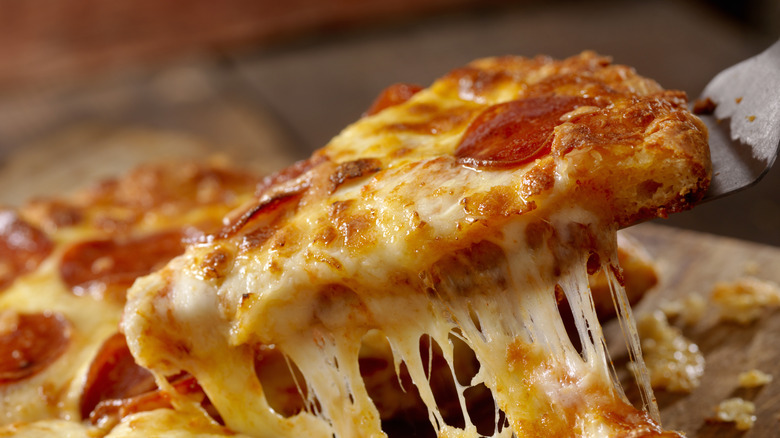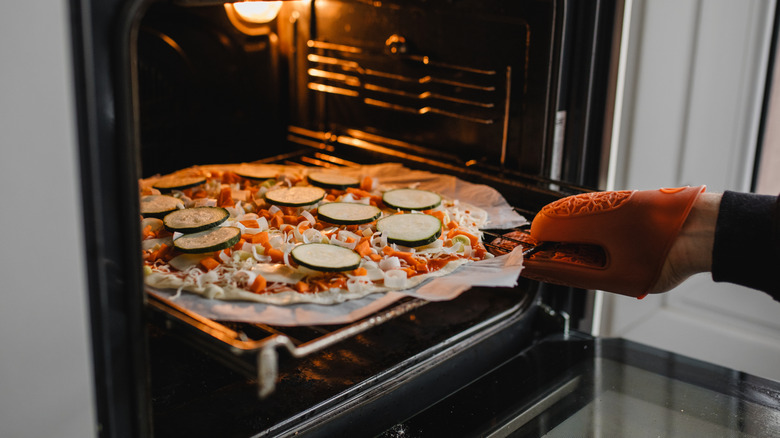The Best Mozzarella, According To Pizza Pros
My five-year stint as a pizzamaker taught me many things, like what separates a good pizza from a superlative one. There are a few things that pizza pros have that a home pizzamaker doesn't, like industrial equipment and years of knowhow (and probably some gnarly oven burns, unfortunately). But what a home pizza enthusiast can do is source some pretty great ingredients for their pies, and one secret for great pizza is in a high-quality mozzarella.
Many pizzerias get their cheese from one of two brands: Galbani or Grande — and one of them is likely available at your grocery store, while the other is mostly available to foodservice professionals. While cheese is only one aspect of your homemade pizza game, it's one of those things your taste buds fixate on with every bite, and we all know it's one of the focal points of most pies.
There's a few things to note when it comes to buying these products, like their accessibility and which types work best under certain conditions, so you'll have to keep that in mind when hunting around for the best ingredients to use on your homemade pizza. Overall, because of its wide availability and ease of use, Galbani low moisture mozzarella is going to be the best choice for most at-home pizza makers.
What type of mozzarella is best for pizza?
Pizzamakers look for a few factors in a great pizza cheese: salt content, fat content, the way it melts, and overall flavor. Though mozzarella can be a pretty neutral cheese, if you pay close attention, the various brands and products all taste slightly different. At Paulie Gee's Logan Square, where I used to work, we actually used both Grande and Galbani, depending on the application. I asked my former boss, Paulie Gee's owner Derrick Tung, why he decided on these particular brands and how the restaurant uses them.
"The dominant brands in most pizzerias are Galbani and Grande," Tung confirmed. "Depending on style of pizza and what we're going for, we've used both for different things."
But it also comes down to personal preferences as well. "We've personally found that we prefer the flavor of Galbani in our triple blind taste tests, but that's because we like a slightly tangier mozzarella for our pizzas," Tung said.
Grande's fresh cheeses, like its fior di latte (Italian for "flower of milk"), are stellar for Neapolitan-style pizza applications. Fior di latte is a fresh cow's milk cheese that's extremely creamy and mild and helps the flavors of other ingredients like bright crushed tomatoes and soft, yeasty, pizza crust stand out.
Why you should opt for full-fat mozzarella on your pizza
If you're going to make pizza from scratch (or mostly from scratch), you might as well make one that's more indulgent than what you can buy premade. Part-skim varieties of mozzarella don't have that extra silkiness to them once they're melted, and they become somewhat chewy and tough when they cool down.
For general-purpose pizza making, you should opt for low moisture varieties, as fresh mozzarella does weep water during the baking process and can render your conventional oven-baked pizza soggy. Fresh mozzarella is more used for Neapolitan-style pizza. Because this type of pizza cooks within a few minutes, moisture pooling out of the fresh cheese isn't as big of an issue, plus you tend to use less cheese altogether on Neapolitan-style. But creating Neapolitan-style pizza typically involves the use of specialized home pizza ovens, which can get pretty pricey in terms of hardware. Fresh mozzarella also spoils quickly, so be sure to store it properly.
So that's why Galbani low moisture whole milk mozzarella is an ideal choice for home pizza making. As I mentioned, Grande cheeses are terrific, but they can be hard to find at a retail store. If you're really on the hunt, you'll likely be able to score some Grande from a restaurant supply store (some of which don't require memberships), but only in large quantities, like a five-pound block, or in giant tubs for the fresh variety. I have, however, found Galbani products at my local grocery store. The one you'll want to reach for is the whole milk, low moisture mozzarella that comes in a one-pound loaf. I tend to find it in the dairy section rather than the deli portion of the grocery store.
Always shred or slice your own mozzarella
Notice I mentioned earlier that you want to purchase a ball of cheese, as opposed to shredded. Bags of pre-shredded cheese have cellulose added to them, which is a plant-based material that keeps the shreds from clumping together. Those are fine for a lot of general uses straight from the bag, but on pizza, it will impart a slight graininess to your final product. That's not ideal when you want that luxurious bite of silky, stretchy, cheese on your pie.
So either shred or slice the cheese into thin slices yourself, since it really does make that much of a difference. You can shred the old fashioned way using a box grater (provided you're not making a ton of pizza), but if you find that too arduous, you'll find that some food processors come with a blade attachment that's made specifically for shredding larger amounts cheese, quickly. Now that you're armed with the brands, techniques, and mozzarella processing tips that professionals use, you've got one more way to make your homemade pizza that much better — just don't forget to rest your homemade pizza dough before assembling your pies.



